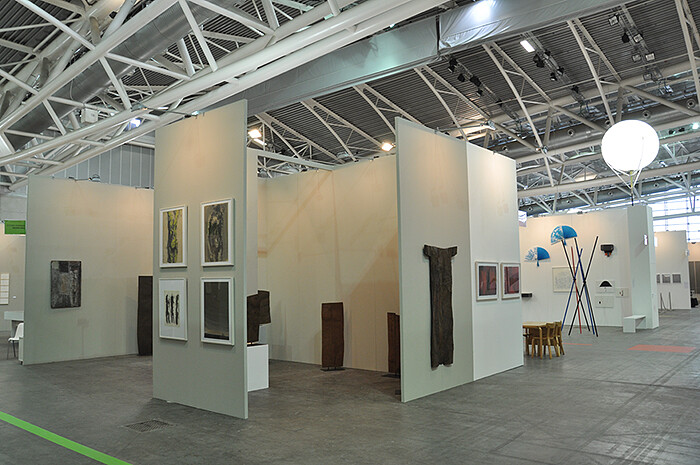Recalling Gertrude Stein’s “Rose is a rose is a rose is a rose,” we could equally say that an art fair is an art fair is an art fair is an art fair. And the 19th edition of Artissima—a fair with a well-deserved reputation for quality—moved a step away from the program-based identity that has characterized its past. Instead, this year, it appeared as it has always been—that is, as an art fair.
For better or worse, such a return to basics is a radical gesture that characterizes the fair’s new direction. This is because it is always sexier to wrap an essentially commercial institution in a heady cloak of discourse-heavy events and projects that attract and engage all sorts of cultural producers. But these extra-fair activities are presented ipso facto in the midst of the strange vacuum that is an art fair, and most of the time they are received by absent-minded, hurried, tired, and, yes, visually over-stimulated spectators, who have fallen victim to the disorientating consequences of spending too much time in an environment that treats them as consumers. With its artificial lighting and sprawling yet maze-like configuration, an art fair is certainly not the best place to set up talks, debates, presentations, performances, and the like.
For that reason, this year’s Artissima is refreshingly old-fashioned; lacking but not lacking at all. There are a few things that are not to be missed.
First stop, Pinksummer, Genoa, for Tomas Saraceno’s Spica (star) (2012). Following the success of the artist’s installation On Space Time Foam currently on display at HangarBicocca, Milan, this is the occasion to have your very own private bubble: an alluring, iridescent sphere that turns Saraceno’s visionary engineering into absolute domestic psychedelia. But for a more down-to-earth counterpoint to Saraceno’s heavenly sphere, see Kirsten Pieroth’s Relativity Egg (2012) at Franco Noero, Turin: a gigantic plaster and papier-mâché egg clumsily standing next to a tiny (well, life-sized) egg scale. Einstein, roll over. In tune with that fine sense of humor was Jacopo Miliani’s Knowledge is Good (2012) at Frutta gallery, Rome. The artist deconstructed the 1978 American cult comedy National Lampoon’s Animal House by turning it into an illustrative compendium of contemporary art, observing the similarities between the film’s scenes and certain artworks, such as Jeremy Deller’s Battle of Orgreave (2001) or Bruce Nauman’s Self-portrait as a Fountain (1966-67).
This year, the curatorial section of the fair seemed to be imbedded in a spirit of discovery, which led its team to be particularly attentive to new territories, in the case of the Present Future Award for young artists, and to the showcase the work of lesser known artists of the 1960s and 70s in the Back to the Future Section. Daniel Steegmann Mangrané’s 16mm (2008–2011) was realized in the heart of Brazil’s rainforest according to a very specific set of procedures in which physical distance corresponded to the length of the film. Taken in a single shot, Mangrané reawakens the experiments of the Structuralists with an exotic, tropical twist.
At a moment in which Italy is revaluating its kinetic heritage through a series of exhibitions dedicated to the Arte Programmata movement of the early 1960s, it is worth considering the work of Piero Fogliati, one of the inheritors of this tradition, whose works explore the physical and psychological boundaries of perception. Alone the colored shadows produced by his Mechanic Prism (1967) are worth a visit to the fair.
And despite having widely exhibited since the 1970s—and having collaborated with magazines such as I-D, Interview, and Vogue—the Swiss photographer Walter Pfeiffer still remains a rather marginal figure when compared to those he has influenced such as Nan Goldin, Wolfgang Tillmans, Jack Pierson, Ryan McGinley, or others who continue to explore the poetry inherent in photographing one’s friends (or interiors, fruits, socks, and whatnots). The images presented here give an important account of Pfeiffer’s outstanding body of work.
At Artissima Lido this year, independent spaces were paired up with lesser-known art-related institutions that allowed visitors to discover fascinating organizations (outside of the contemporary art realm) with incredible venues. At the Museum of Resistance, Deportation, War, Human Rights and Freedom, for instance, one could see an impressive selection of (mostly) Lebanese films on the theme of resistance, conceived by curators Marwa and Mirene Arsanios (the founders of 98weeks). The cinema in this museum, with its red velvet chairs and intimate environment, is the perfect, if paradoxically plush, setting for viewing these films.
Andrew Berardini (critic) and Lauren Mackler (of Public Fiction), the curators of “Treating Shadows as Real Things,” also created an impressive dialogue with an unusual location. Presented in the Church of the Holy Shroud, the show makes use of illusion and reflection—typical Baroque features—to produce a disorienting physical experience. A mirror was placed on the floor of the nave, thus not only upending the physical space of the church, but also doubling all the artworks that were arranged on top of the looking glass, such as Samara Golden’s set of Masks (2012) or De Chirico’s painting Metaphysical Interior (1950), which is very “meta” here, indeed, as the plazas that inspired De Chirico were those of Turin.
In the National Archives, curated by the Parisian Irmavep Club, Phillip Sollmann’s Freeze (divided sensations) (2012), consists of an audio installation divided up between the radial building’s four wings. These four different soundscapes produce a parted soundtrack for an archive, replicating its conditions of segregation. Ambient sounds, white noise, the voice of a man singing: variations, segregated down different alleys, yes, and part of an art fair—an art fair by any other name smells just as sweet.







